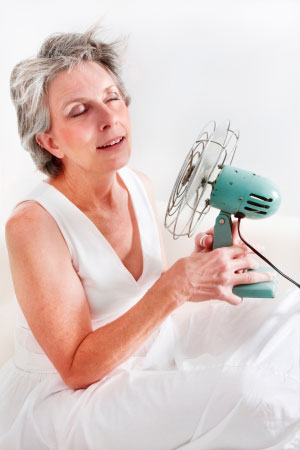
Menopause-related hot flashes and night sweats can last for years.
Overview
During menopause the majority of women will experience both emotional and physical symptoms. The most common symptom that women complain about are hot flushes and night sweats. More than 57% of all women will experience these two symptoms during their menopause years.
These symptoms most commonly begin between the age of 45 and 49 years and women with moderate to severe hot flushes may continue to experience them for an average of 10 years. Some women may continue with hot flushes and sweats beyond the age of 80.
What are hot flushes?
Hot flushes are described as a sudden feeling of heat or warmth often accompanied by profuse sweating. It may also present itself as:
- Increased heart rate
- Red or flushed face
- Heat affecting the whole body
Hot flushes can continue for up to 30 minutes or more at a time or may be as short as just a few seconds. The sensation often begins in the face or chest and may spread throughout the body. The surface of the skin often feels hot to the touch.
Hot flushes can sometimes be associated with other symptoms such as:
- Nausea
- Anxiety
- Light headedness
- General feeling of being unwell
- Sleeplessness – constantly being woken by overheating and night sweats
- An overactive mind
How long will I be having hot flushes for?
Each woman is different and therefore their symptoms, severity and duration of symptoms will be different. According to a recent study carried out in the United States called the Study of Women’s Health Across the Nation (SWAN), vasomotor symptoms such as hot flushes and night sweats will last between 7 to 11 years.
One factor determining the duration of these symptoms is the timing of the onset of hot flushes and night sweats. If a woman begins to experience these symptoms prior to cessation of menstruation or during the peri-menopause stage then the symptoms average more than 11 years while women who are already post menopausal at the onset of symptoms averaged 3.4 years.
Are you experiencing this symptom?
Take the questionnaire to determine if it may be a sign of menopause, and discover how we can help
The typical hot flush experience
Mostly affecting the face and neck, hot flushes can also affect the whole body. Women report having to remove clothing and stand in front of the air conditioner or fan. The typical description: “Suddenly my face goes red, beads of sweat appear on my forehead and run down my face and neck accompanied with feeling hot and sticky.”
What causes and triggers hot flushes?
Hot flushes can be caused by hormonal fluctuations in the early stages of menopause and continue long after menopause has passed. They may only last a few months, but usually they will continue for many years.
Oestrogen levels decline in menopause and this appears to be the most common cause of hot flushes in women. These lower levels of oestrogen have a significant effect on the hypothalamus. Located in the brain, the hypothalamus controls the sex hormones, body temperature, sleep function and even appetite.
Although not completely understood, it is thought that the fall in oestrogen levels somehow affect the hypothalamus causing confusion whereby it senses that the body temperature is too hot, thus triggering hot flushes which is designed to cool down the body. More blood rushes to the skin, causing redness and sweating.
Hot flushes occur in the winter and the summer but seem to be more common in the summer months. Women having hot flushes often find themselves opening windows and doors or putting on the fan in the wintertime because they feel overheated. This can be inconvenient to those around who do feel the cold.
Other Factors that cause hot flushes:
- Anxiety
- Stress
- Spicy Foods
- Alcohol
What can I do to prevent hot flushes?
Hormone deficiency is the recognised cause of hot flushes and so hormone replacement in the correct balance is the most effective way of treating these symptoms. Lifestyle changes can also make a difference in reducing hot flushes and sweats.
Lifestyle changes include:
- Stop smoking
- Improve diet
- Regular exercise
- Avoid spicy foods
- Avoid excess alcohol and caffeine
- Dress in layers
Treatment of Hot Flushes
Alternative Herbal Therapies:

Based on current research, black cohosh is most likely to relieve symptoms related to reductions or imbalances in the hormone oestrogen
Black Cohosh
Black cohosh is an herb native to Eastern North America.
Various studies conducted on black cohosh have shown potential benefits for people with menopausal symptoms however evidence of effectiveness is inconclusive.
Black Cohosh may be beneficial for hot flushes, night sweats, mood swings, low libido and poor sleep. However, studies suggest positive benefits did not exceed 6 months to 1 year of use.
Due to this and possible side effects on the liver and liver damage, use of Black Cohosh is not recommended long term.

Based on current research, black cohosh is most likely to relieve symptoms related to reductions or imbalances in the hormone estrogen
Red Clover
Red Clover is a plant native to Europe, Western Asia and Northwest Africa. The flower top is the section of the plant that is used to produce medicinal products.
There have been mixed findings on the effectiveness of Red Clover for the treatment of hot flushes, night sweats and breast tenderness. Some research has shown that taking red clover by mouth for up to one year does not reduce these symptoms although some evidence suggests that certain products containing red clover reduces the severity of symptoms but not the frequency.
Red Clover may increase Oestrogen and therefore some symptoms can become worse by exposure to increased Oestrogen. Therefore, Red Clover products should only be used under professional advice.
Hormone Replacement Therapy
Oestrogen only hormone therapy
Oestrogen only HRT can come in many forms:
- Pill – Most common treatment
- Patch – Worn on the skin and replaced periodically
- Topical – Creams, gels or sprays
- Vaginal – Creams or pessaries used specifically for the treatment of vaginal dryness

Bio-identical hormones, also known as body-identical hormones, which have exactly the same chemical and molecular structure as the hormones that are produced by your body
Bio-identical Hormone Replacement Therapy (BHRT)
Book A No Obligation Free First Medical Consultation
Speak with one of our doctors confidentially to discuss & if you are suitable a treatment plan will be prescribed.